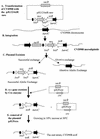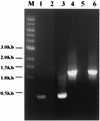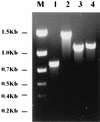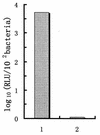Construction of a tetR-integrated Salmonella enterica serovar Typhi CVD908 strain that tightly controls expression of the major merozoite surface protein of Plasmodium falciparum for applications in human Vaccine production
- PMID: 11895968
- PMCID: PMC127878
- DOI: 10.1128/IAI.70.4.2029-2038.2002
Construction of a tetR-integrated Salmonella enterica serovar Typhi CVD908 strain that tightly controls expression of the major merozoite surface protein of Plasmodium falciparum for applications in human Vaccine production
Abstract
Attenuated Salmonella strains are an attractive live vector for delivery of a foreign antigen to the human immune system. However, the problem with this vector lies with plasmid segregation and the low level of expression of the foreign gene in vivo when constitutive expression is employed, leading to a diminished immune response. We have established inducible expressions of foreign genes in the Salmonella enterica serovar Typhi CVD908 vaccine strain using the tetracycline response regulatory promoter. To set up this system, a tetracycline repressor (tetR) was integrated into a defined Delta aroC locus of the chromosome via suicide plasmid pJG12/tetR-neo. To remove the neo gene conferring kanamycin resistance from the locus, a cre expression vector under the control of the tetracycline response promoter was transformed into the clone; expression of the Cre recombinase excised the neo gene and generated the end strain CVD908-tetR. Expression of the luciferase reporter gene in this strain is dependent on the presence of tetracycline in the medium and can be regulated up to 4,773-fold. Moreover, the tightly controlled expression of major merozoite surface protein 1 (MSP1) and parts of Plasmodium falciparum was achieved, and the product yield was increased when the inducible expression system was employed. Inoculation of bacteria harboring plasmid pZE11/MSP1(42) in mice produced the protein in liver and spleen controlled by the inducer. The persistence of the plasmid-carrying bacteria in mice was determined. Peak colonization of both liver and spleen was detected on the third day postinoculation and was followed by a decline in growth curves. After 14 days postinfection, the majority of the bacteria (>90%) recovered from the liver and spleen of the mice retained the plasmid when expression was induced; this clearly indicated that stability of the expression vector in vivo was improved by inducible expression. Establishment of the regulatory system in the vaccine strain may broaden the range of its use by enhancing plasmid stability and expression levels in vivo. Moreover, the availability of the vaccine strain inducibly expressing the entire MSP1 provides possibilities for examining its immunogenicity, particularly the cellular response in animal models.
Figures






Similar articles
-
[Inducible expression of MSP1 gene of Plasmodium falciparum by a tetracycline controlled promoter in Salmonella typhi CVD908 strain].Zhonghua Yi Xue Za Zhi. 2000 Oct;80(10):780-3. Zhonghua Yi Xue Za Zhi. 2000. PMID: 11372377 Chinese.
-
Enhanced immunity to Plasmodium falciparum circumsporozoite protein (PfCSP) by using Salmonella enterica serovar Typhi expressing PfCSP and a PfCSP-encoding DNA vaccine in a heterologous prime-boost strategy.Infect Immun. 2007 Aug;75(8):3769-79. doi: 10.1128/IAI.00356-07. Epub 2007 May 14. Infect Immun. 2007. PMID: 17502396 Free PMC article.
-
Immunogenic properties of a recombinant fusion protein containing the C-terminal 19 kDa of Plasmodium falciparum merozoite surface protein-1 and the innate immunity agonist FliC flagellin of Salmonella typhimurium.Vaccine. 2010 Apr 1;28(16):2818-26. doi: 10.1016/j.vaccine.2010.02.004. Epub 2010 Feb 17. Vaccine. 2010. PMID: 20170765
-
Salmonella enterica serovar Typhi live vector vaccines finally come of age.Immunol Cell Biol. 2009 Jul;87(5):400-12. doi: 10.1038/icb.2009.31. Epub 2009 May 5. Immunol Cell Biol. 2009. PMID: 19417771 Free PMC article. Review.
-
Strategies for Enhancement of Live-Attenuated Salmonella-Based Carrier Vaccine Immunogenicity.Vaccines (Basel). 2021 Feb 17;9(2):162. doi: 10.3390/vaccines9020162. Vaccines (Basel). 2021. PMID: 33671124 Free PMC article. Review.
Cited by
-
Tight modulation of Escherichia coli bacterial biofilm formation through controlled expression of adhesion factors.Appl Environ Microbiol. 2007 May;73(10):3391-403. doi: 10.1128/AEM.02625-06. Epub 2007 Mar 23. Appl Environ Microbiol. 2007. PMID: 17384304 Free PMC article.
-
The application of Tet repressor in prokaryotic gene regulation and expression.Microb Biotechnol. 2008 Jan;1(1):2-16. doi: 10.1111/j.1751-7915.2007.00001.x. Microb Biotechnol. 2008. PMID: 21261817 Free PMC article. Review.
-
Controlling gene expression in mycobacteria with anhydrotetracycline and Tet repressor.Nucleic Acids Res. 2005 Feb 1;33(2):e21. doi: 10.1093/nar/gni013. Nucleic Acids Res. 2005. PMID: 15687379 Free PMC article.
-
Status quo of tet regulation in bacteria.Microb Biotechnol. 2022 Apr;15(4):1101-1119. doi: 10.1111/1751-7915.13926. Epub 2021 Oct 29. Microb Biotechnol. 2022. PMID: 34713957 Free PMC article. Review.
-
Borrelia burgdorferi ftsZ plays a role in cell division.J Bacteriol. 2006 Mar;188(5):1969-78. doi: 10.1128/JB.188.5.1969-1978.2006. J Bacteriol. 2006. Retraction in: J Bacteriol. 2006 May;188(9):3430. doi: 10.1128/JB.188.9.3430.2006. PMID: 16484209 Free PMC article. Retracted.
References
-
- Aley, S. B., J. W. Barnwell, M. D. Bates, W. E. Collins, and M. R. Hollingdale. 1987. Plasmodium vivax: exoerythrocytic schizonts recognized by monoclonal antibodies against blood-stage schizonts. Exp. Parasitol. 64:188-194. - PubMed
-
- Barry, E. M., O. G. Gomez-Duarte, S. Chatfield, R. Rappuoli, M. Dizza, G. A. Losonsky, J. E. Galen, and M. M. Levine. 1996. Expression and immunogenicity of pertussis toxin S1 subunit-tetanus toxin fragment C fusions in Salmonella typhi vaccine strain CVD 908. Infect. Immun. 64:4172-4181. - PMC - PubMed
-
- Cardenas, L., and J. D. Clements. 1993. Stability, immunogenicity and expression of foreign antigens in bacterial vaccine vectors. Vaccine 11:126-135. - PubMed
Publication types
MeSH terms
Substances
LinkOut - more resources
Full Text Sources
Other Literature Sources
Research Materials

